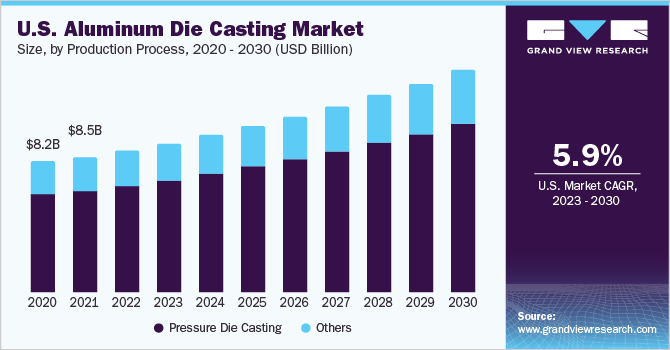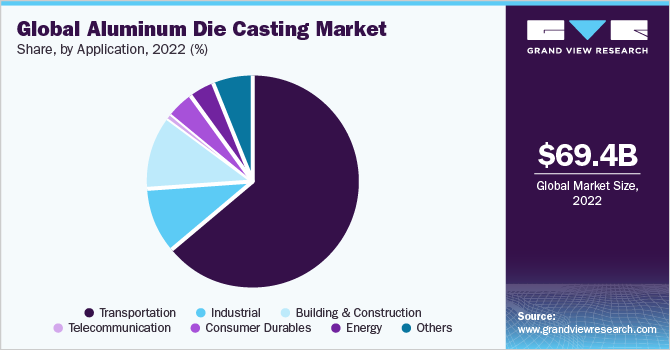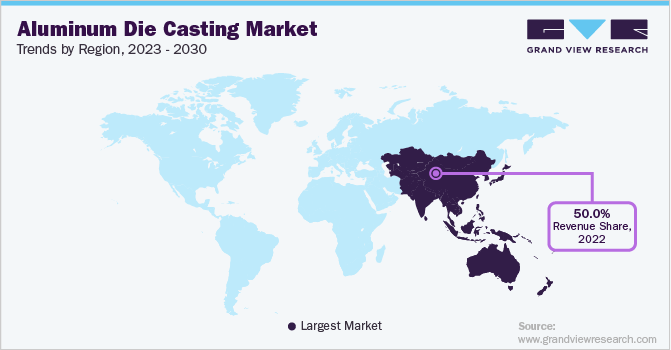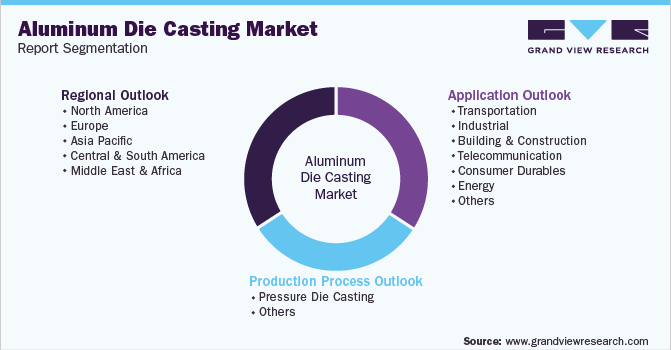- Home
- »
- Advanced Interior Materials
- »
-
Global Aluminum Die Casting Market Share Forecast ReportGVR Report cover
![Aluminum Die Casting Market Size, Share & Trends Report]()
Aluminum Die Casting Market Size, Share & Trends Analysis Report By Application (Transportation, Industrial, Building & Construction), By Production Process, By Region, And Segment Forecasts, 2023 - 2030
- Report ID: GVR-3-68038-324-9
- Number of Report Pages: 170
- Format: PDF, Horizon Databook
- Historical Range: 2018 - 2021
- Forecast Period: 2023 - 2030
- Industry: Advanced Materials
Report Overview
The global aluminum die casting market size was valued at USD 69.36 billion in 2022 and is estimated to grow at a compound annual growth rate (CAGR) of 5.4% from 2023 to 2030. Increasing usage of aluminum in various applications, such as transportation and telecommunication, is expected to boost market growth during the forecast period. A rising preference for high strength and lightweight castings is a prominent driving factor. Manufacturers are required to comply with the regulations, to enhance fuel efficiency and reduce harmful emissions, in the transportation industry. This is possible by the incorporation of lightweight materials in production of the vehicles.

The U.S. is a prominent producer and consumer of aluminum die casting. The upward growth trajectory of the U.S. market was severely impacted in 2020 as the product demand reduced drastically on account of the emergence of the COVID-19 pandemic, which led to a downfall in both production and consumption activities. However, during this period, the acquisition activities increased significantly wherein global players targeted regional players.
For instance, in March 2020, Martinrea International Inc., which is engaged in the design, development, and manufacturing of propulsion systems and lightweight structures, announced that it has acquired the structural components business segment of Metalsa S.A. de C.V. The acquisition has resulted in the addition of six plants including facilities in the U.S., Mexico, Germany, South Africa, and two in China. The strategic initiative is projected to propel the growth of Martinrea International Inc., thereby expanding its product portfolio and customer base.
Even though, the product demand is expected to remain steady during the forecast period. The rise in military spending in the country, coupled with rising investments in automation and robotics, is anticipated to prove fruitful for the market growth. The U.S. has been ranking first in terms of military spending in the world for the past many years. The utilization of castings in military aircraft and other equipment is likely to augment due to the rising spending in the military sector.
The growth of the building and construction industry is another growth driver for the market. For instance, construction spending in the U.S. increased by 1.7% from December 2020 to January 2021. This is a positive sign for the market. Aluminum die castings find application in windows, curtain walling, shop partitions, cladding, and prefabricated buildings, among others, in the construction industry.
The market growth declined in 2020 and was expected to remain sluggish in 2021 as well because of the pandemic. A steep decline in raw material prices, unemployment, minimal production, and disruptions in transport impacted the manufacturing of the aluminum die castings. For example, primary aluminum prices peaked at USD 1,810 per ton on January 21, 2020, and dropped to 1,421.5 on April 8, 2020.
Production Process Insights
Based on production process, pressure die casting held the largest revenue share of more than 78.0% in 2022. The large share is attributed to phenomenal characteristics provided by the process including easy filling of cavity, smooth surface finish, tighter dimension tolerance, and strong mechanical properties. The growing preference for pressure die casting is expected to propel the market growth, especially in the automotive sector, during across the coming years.
Pressure die casting is further segmented into high and low, where the former dominated the market in 2022. The latter’s share is limited owing to the long casting cycle. High pressure die casting (HPDC) is preferred for delivering higher production rates and is thus extensively used in various industries.
The other types of die casting include vacuum die casting and squeeze die casting. The demand for these aforementioned processes is likely to be generated by novel applications, such as the casting of turbine blades and solar sensors. Due to the refined grain size and strong mechanical properties, the finished product offers higher tensile strength and lowers stress rupture capability.
Application Insights
Based on application, the transportation segment held the largest revenue share of over 64.0% in 2022. Within the transportation segment, lightweight vehicles are considered to be the key factor behind the growth of aluminum products. The share of die-cast parts is expected to grow considerably over the forecast period.

The industrial segment comprises agricultural, construction, and mining equipment. The aluminum cast products are used in the components of the aforementioned machinery. The rising infrastructural developments in Asian countries are expected to boost the demand for construction equipment across the forecast period.
The product demand in the building and construction segment is dominated by the use of aluminum die-cast products in houses, with various applications such as door handles, roofing, curtain walling, and windows. The rising replacement of iron and steel due to the changing consumer preferences is impacting the market growth on a positive note.
Regional Insights
Asia Pacific dominated the market and accounted for over 50.0% share of the global revenue in 2022. The region is characterized by the presence of skilled labor at low cost, which makes it the most lucrative region for manufacturers to set up production facilities. Moreover, a shift in the global production landscape toward South Asian countries is expected to positively influence the market growth over the forecast period.

China accounted for a key share in the regional market in 2022, considering the widespread presence of the end-use industries in the country. It is one of the largest manufacturing hubs in the world. Moreover, China spends a large amount on military and defense. Although China’s manufacturing operations were also impacted owing to the COVID-19 pandemic, the country reported a fast recovery compared to other parts of the world.
North America is anticipated to witness steady growth across the forecast period. Emphasis on reaching pre-covid levels and the incorporation of sustainable solutions is anticipated to augment product demand in the region. For example, in December 2020, Rio Tinto introduced a new series of high-quality aluminum alloys to support recycling by the die casters. Such initiatives are anticipated to prove fruitful for the market growth over the forecast period.
Key Companies & Market Share Insights
The market for aluminum die casting is extremely competitive owing to the presence of numerous players across the globe. The ongoing coronavirus pandemic had a harsh impact on the sales and production of the players in the market. Companies had halted their production activities during the lockdown period, which had a negative impact on their sales.
With ease in restrictions, many companies have resumed their operations by adhering to safety protocols. In September 2020, Tesla announced its plan to replace hundreds of robots in its car factory in Germany with giant machines for making simpler chassis parts for raising its EV production. Moreover, the company plans to build compact cars for the European markets, which is further anticipated to bring more investments in the manufacturing facility and augment demand for aluminum die casting. Some prominent players in the global aluminum die casting market include:
-
Alcast Technologies
-
BUVO Castings
-
Chongqing CHAL Precision Aluminium Co., Ltd.
-
Consolidated Metco, Inc.
-
Endurance Technologies Limited
-
FAIST Group
-
GF Casting Solutions
-
GIBBS
-
Martinrea Honsel Germany GmbH
-
Madison-Kipp Corporation
-
Ryobi Limited
Aluminum Die Casting Market Report Scope
Report Attribute
Details
Market size value in 2023
USD 72.57 billion
Revenue forecast in 2030
USD 105.63 billion
Growth rate
CAGR of 5.4% from 2023 to 2030
Base year for estimation
2022
Historical data
2018 - 2021
Forecast period
2023 - 2030
Quantitative Units
Volume in kilotons, revenue in USD million, and CAGR from 2023 to 2030
Report coverage
Volume forecast, revenue forecast, competitive landscape, growth factors, and trends
Segments covered
Production process, application, region
Regional scope
North America; Europe; Asia Pacific; Central & South Africa; Middle East & Africa
Country scope
U.S.; Canada; Mexico; Germany; France; Italy; Russia; U.K.; Turkey; China; India; Japan; South Korea; Brazil; South Africa
Key companies profiled
Alcast Technologies; BUVO Castings; Chongqing CHAL Precision Aluminium Co., Ltd.; Consolidated Metco, Inc.; Endurance Technologies Limited; FAIST Group; GF Casting Solutions; GIBBS; Martinrea Honsel Germany GmbH; Madison-Kipp Corporation; Ryobi Limited
Customization scope
Free report customization (equivalent up to 8 analysts working days) with purchase. Addition or alteration to country, regional & segment scope.
Pricing and purchase options
Avail customized purchase options to meet your exact research needs. Explore purchase options
Global Aluminum Die Casting Market Report Segmentation
This report forecasts revenue and volume growth at the global, regional, and country levels and provides an analysis of the latest industry trends and opportunities in each of the sub-segments from 2018 to 2030. For this study, Grand View Research has segmented the global aluminum die casting market report based on production process, application, and region:

-
Production Process Outlook (Volume, Kilotons; Revenue, USD Million, 2018 - 2030)
-
Pressure Die Casting
-
High Pressure Die Casting
-
Low Pressure Die Casting
-
-
Others
-
-
Application Outlook (Volume, Kilotons; Revenue, USD Million, 2018 - 2030)
-
Transportation
-
General Road Transportation
-
Sports Road Transportation
-
Heavy Vehicles
-
Aerospace & Aviation
-
-
Industrial
-
Agricultural Equipment
-
Construction Equipment
-
Others
-
-
Building & Construction
-
Telecommunication
-
Consumer Durables
-
Energy
-
Others
-
-
Regional Outlook (Volume, Kilotons; Revenue, USD Million, 2018 - 2030)
-
North America
-
U.S.
-
Canada
-
Mexico
-
-
Europe
-
Germany
-
France
-
Italy
-
Russia
-
UK
-
Turkey
-
-
Asia Pacific
-
China
-
India
-
Japan
-
South Korea
-
-
Central & South America
-
Brazil
-
-
Middle East & Africa
-
South Africa
-
-
Frequently Asked Questions About This Report
b. The global aluminum die casting market size was estimated at USD 69.36 billion in 2022 and is expected to reach USD 72.57 billion in 2023.
b. The aluminum die casting market is expected to grow at a compound annual growth rate of 5.4% from 2023 to 2030 to reach USD 105.63 billion by 2030.
b. Transportation was the key application segment of the market with a revenue share of above 64.0% of the market in 2022.
b. Some of the key players operating in the aluminum die casting market Alcast Technologies, BUVO Castings, Chongqing CHAL Precision Aluminium Co., Ltd., Consolidated Metco, Inc., Endurance Technologies Limited, FAIST Group, GF Casting Solutions, GIBBS, Martinrea Honsel Germany GmbH, Madison-Kipp Corporation, and Ryobi Limited.
b. Rising focus towards incorporation of lightweight materials such as aluminum in vehicle production is anticipated to augment market growth over the forecast period.
Share this report with your colleague or friend.
![gvr icn]()
NEED A CUSTOM REPORT?
We can customize every report - free of charge - including purchasing stand-alone sections or country-level reports, as well as offer affordable discounts for start-ups & universities. Contact us now
![Certified Icon]()
We are GDPR and CCPA compliant! Your transaction & personal information is safe and secure. For more details, please read our privacy policy.
We are committed towards customer satisfaction, and quality service.
"The quality of research they have done for us has been excellent."





